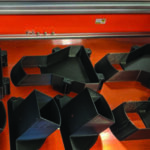Back in May, German RepRap unveiled its new Liquid Additive Manufacturing technology. Since then, they’ve made quite some strides, as was made evident recently with the reveal of their new polyurethane based 3D printing materials. The chemical turns solid upon processing to produce an object with isotropic mechanical properties. Additionally, parts PU produces have properties on par with injection molded parts.
Polyurethane is an important material. Even if you haven’t heard of it, you’ve most definitely made use of it in your day to day life. It can comprise your mattress foam all the way down to the soles of your shoes. It has a role to play in sports goods, hoses, sealants etc. Potentially, this new manufacturing method could be useful to a host of companies in all sorts of industries.
A lot of the properties of the material come from chemical cross-linking. This allows the material to be consistent and have identical of a property across all directions of its structure. This uniformity is useful for all the products listed earlier. LAM printers tend to operate at very low temperatures considering how they don’t have to deal with material melting. PU is no different, as it operates at room temperature.
Liquid Additive Manufacturing
German RepRap are pioneering the field of Liquid Additive Manufacturing (LAM). It is, in many ways, similar to traditional FFF/FDM but allows for different results. The core difference is that instead of purely heating materials, each layer of the object passes through a curing material. This is referred to as cross-linking.
This method has many benefits associated with it. Firstly, since it operates at room temperature, it saves a lot of energy and it has little to no warpage. Secondly, material shrinkage is very low. For PU, objects will shrink by about 1 to 2 % thanks to LAM.
LAM is generally associated with silicon materials, so it’s interesting to see a polymer like polyurethane is also processable. The short video above shows just how uniformly flexible the end result can be. The object is made from a DOW corning silicon material.
LAM is still a new technology, but it has clear applications and advantages. It can be efficient and it produces entirely new types of materials with high quality parts. It will be interesting to see how it develops as time goes on.
Featured Image retrieved from German RepRap website.












